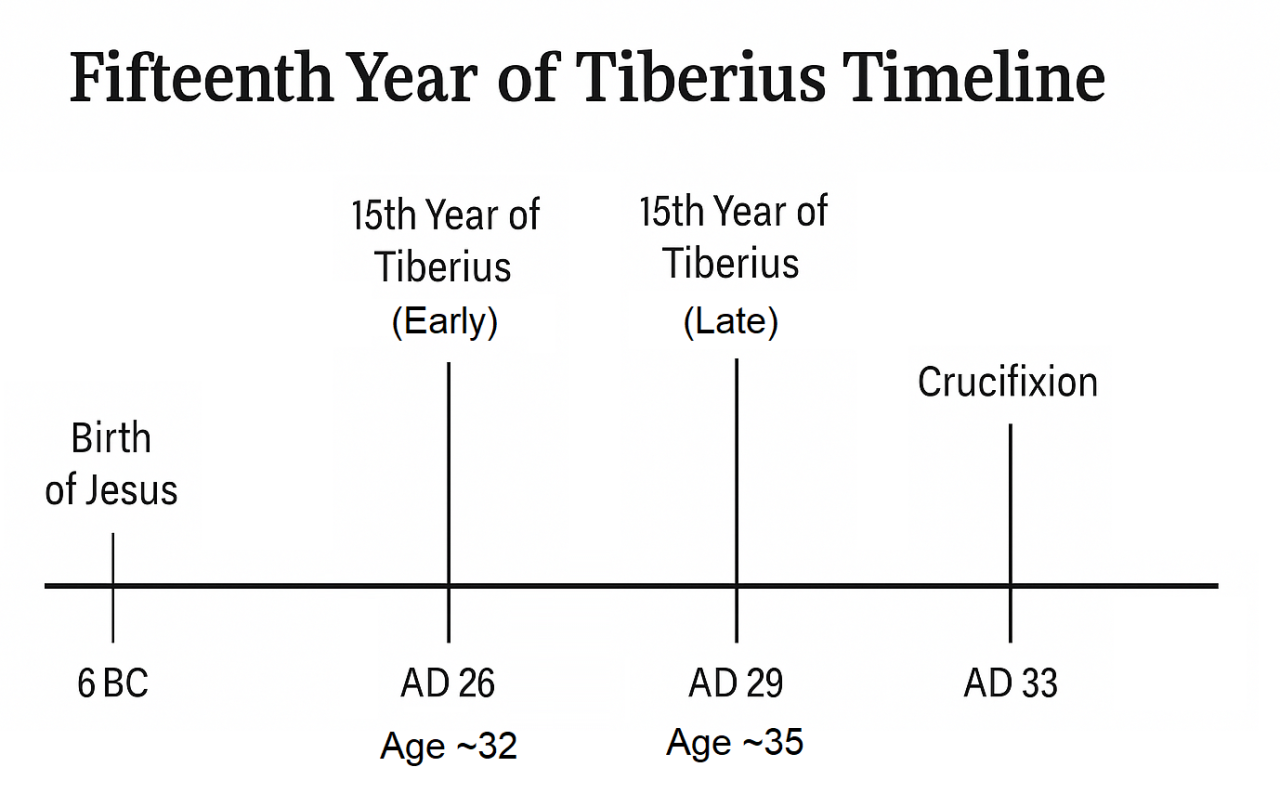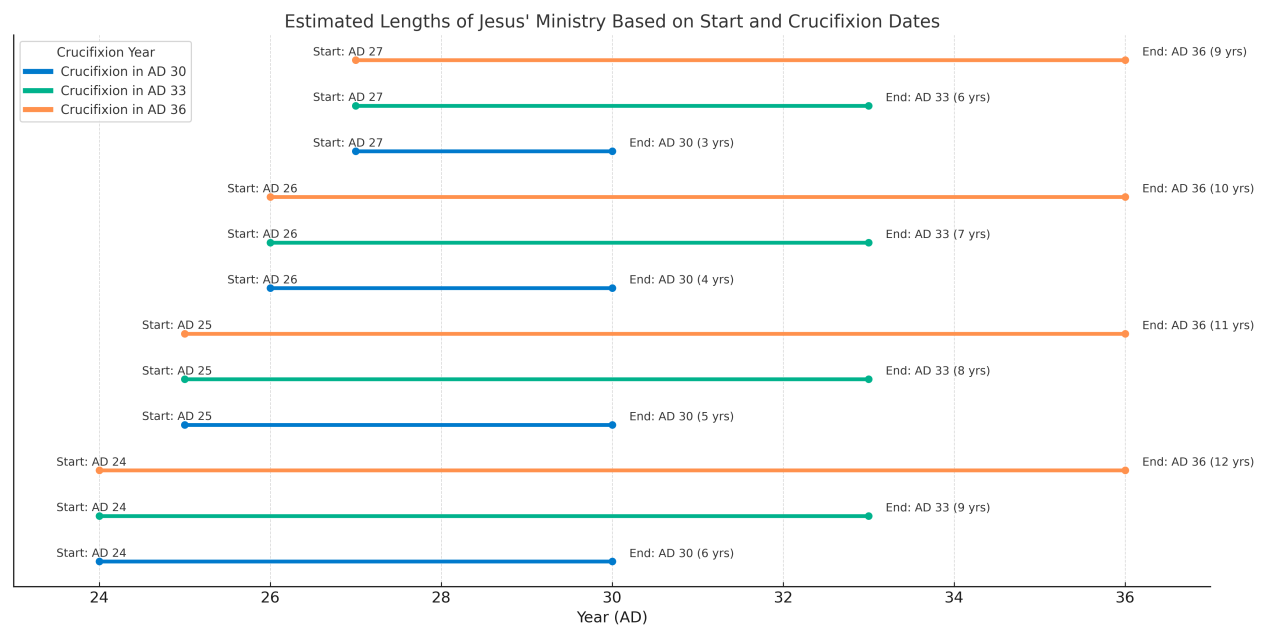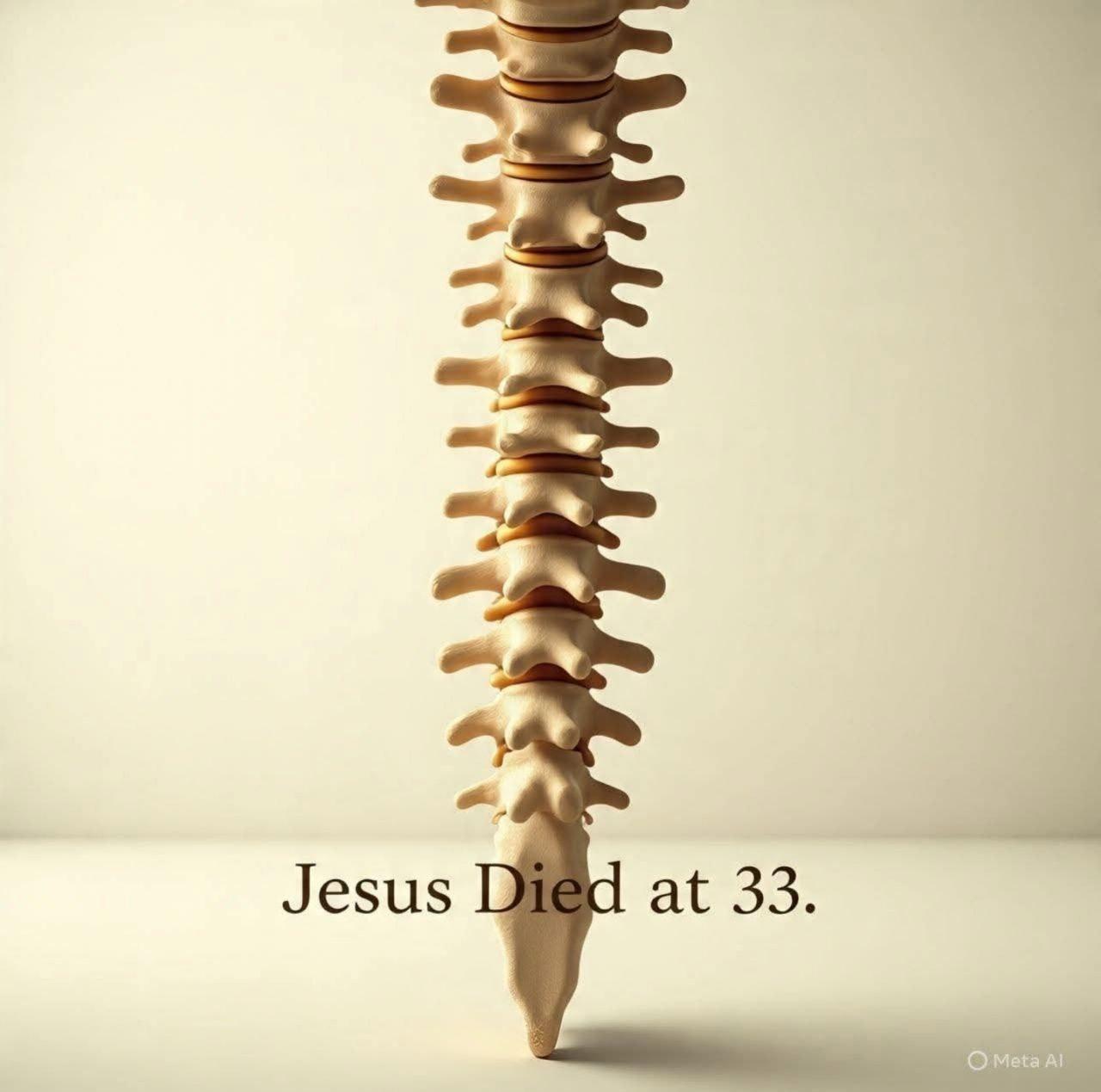How Old Was Jesus When He Died? A Fresh Look At The Historical Clues

We often hear that Jesus was “about 33 years old” when he was crucified and only had a three-year ministry. But have you ever wondered how precise that number is, or why we assume that was his age, especially when Scripture doesn’t specify?
Table of Contents
- The Gospel of Luke: “About Thirty”
- Early Church Testimony: Irenaeus and the Longer Ministry
- Historical Anchors: Birth, Pilate, and the Crucifixion Window
- The Death of Herod
- Cross-referencing with Pilate, Caiaphas, and Jesus
- When Did Tiberius Begin to Reign?
- Astronomy and the Timing of Passover
- Estimated Lengths of Jesus’ Ministry
- Why This Matters
- In Summary
I’ve long wondered about this, especially when the Pharisees accused Jesus of not being close to fifty, which seems odd if he was only in his early 30s. Then I later discovered Irenaeus also had similar thoughts in the second century, and the plot thickened! I’ve had this rumbling around in the back of my mind for a few years now and slowly chewed it over. So now I’m going to try and present the evidence, rather than rely solely on tradition and assumptions, and piece together what the Gospels, early Church Fathers, historical data, and even astronomy can tell us about the potential age of Jesus and the length of his ministry.
What follows is a deeper, richer look at the life and death of Jesus and what we can learn by following the evidence.
The Gospel of Luke: “About Thirty”
Luke 3:23 tells us plainly:
Jesus was about thirty years old when he began his work.
This statement has historically been the anchor point for dating Jesus’ ministry. Most take this to mean he was around 30 at his baptism, which marked the beginning of his public ministry. Something to bear in mind here is that Luke isn’t exact and only says “about thirty”, so he could have been slightly younger or older at the time. But being around the age of 30 would align with the requirements of priests, which Jesus was also fulfilling the role of (Hebrews 2:17; Numbers 4:1–4; Numbers 8:23–25).
But from there, it’s traditionally assumed that Jesus ministered for just three years before his death, mainly based on the Gospel of John, which mentions three Passovers (John 2:13, 6:4, 11:55).
However, John also says at the end of his Gospel in John 21:25:
But there are also many other things that Jesus did; if every one of them were written down, I suppose that the world itself could not contain the books that would be written.
This is a clear reminder, even if John is being hyperbolic here: not everything was recorded. Considering that the Synoptic Gospels only mention one Passover, the number of Passovers we read about in John may not reflect the total number Jesus experienced during his ministry. They may also serve a theological point (three being a prominent number in Scripture) rather than a chronological one.
Early Church Testimony: Irenaeus and the Longer Ministry
In the second century, Irenaeus, bishop of Lyon and disciple of Polycarp (who had also known the Apostle John and was likely his disciple), made an interesting claim about the age of Jesus — and backed it up by saying it was verified by the Apostle John himself!
In Against Heresies (2.22.4–6), Irenaeus wrote:
…our Lord possessed [old age] while He still fulfilled the office of a Teacher, even as the Gospel and all the elders testify, those who were conversant in Asia with John, the disciple of the Lord, [affirming] that John conveyed to them that information. … Some of them, moreover, saw not only John but the other apostles also, and heard the same account from them, and bear testimony to this statement.
He argued that the line in John 8:57:
Then the Jews said to him, ‘You are not yet fifty years old, and have you seen Abraham?’
…would only make sense if Jesus were already in his forties (or at the very least, close to that age). If Jesus had been just thirty, Irenaeus reasons, they would have said, “You are not yet forty” (Adv. Hae. 2.22.5). Although it’s a minority view in the early church, John Chrysostom also appears to agree with Irenaeus. In the fourth century, commenting on verse 57 in his Homily 55 on the Gospel of John, Chrysostom makes a simple, yet profound, statement:
So that we conclude that Christ was nearly forty.
And just like that, one of the heavyweights of the Patristic period concludes something that many others before him had dismissed or ignored.
Whether you agree or not, this shows that some early Christians believed Jesus lived up to his late-30s/early-40s, which suggests a much longer ministry than the traditional three years as often assumed.
Irenaeus’ reasoning for this is also theologically based on how Christ came to live a complete human experience, and by living longer, he sanctified each stage of life:
He came to fulfill all righteousness, and for this reason did not reject the common human experience, but sanctified every age by His likeness to it. He came as an infant to sanctify infancy, as a child to sanctify childhood, as a youth to sanctify youth, and as an elder to sanctify old age. He therefore passed through every stage of life, so that He might be a perfect teacher for all, not merely in words but in age, sanctifying even the elderly because He reached their state as well. (Against Heresies 2.22.6)
Historical Anchors: Birth, Pilate, and the Crucifixion Window
Now that we’ve examined Scripture and some of its early commentators, let's investigate further to see if this more extended age holds up to scrutiny.
Here are some key historical facts we can use to frame Jesus’ timeline:
- Jesus was born before 4 BC, as Herod the Great died that year.
- Caiaphas was appointed high priest by Roman governor Valerius Gratus (predecessor to Pontius Pilate) around 18 AD (Jewish Antiquities 18.2.2 and 18.4.3).
- Pontius Pilate ruled from AD 26 to 36, meaning Jesus had to be crucified within that decade.
- Caiaphas was deposed by Vitellius, the Roman governor of Syria, in 36 or 37 AD.
If Jesus were born in 6 BC, he would have turned 30 in AD 24, and then he would have been about 39 years old at the time of his crucifixion in AD 33. But if he had died in AD 36, he could have been as old as 42.

This makes the traditional age of Jesus being 33 at his death seem more like a minimum estimate than a confirmed fact, and at this point, it appears much less likely than the alternatives.
The Death of Herod
Most scholars conclude that Herod the Great died in early 4 BC, shortly after the March 13 partial lunar eclipse, and shortly before Passover in April 4 BC. A minority of scholars favour a 1 BC date due to another eclipse in January of that year.
The first-century historian Josephus provides several key details which put the emphasis more strongly on the 4 BC date, though:
- Herod died shortly after a lunar eclipse (dated March 13, 4 BC).
- His death occurred before Passover.
Between the eclipse and Passover, several events occurred:
- The execution of his son Antipater.
- A period of illness.
- The gathering of elders to be executed upon his death (though this wasn’t carried out).
- His funeral and burial arrangements.
These events suggest a gap of at least several weeks between the eclipse and Passover. The 4 BC eclipse is most commonly accepted because it better fits the Roman historical context, it aligns with the generally accepted date for the start of the reign of Herod’s sons, who took power soon after his death, and it gives enough time between the eclipse and Passover for the events Josephus described. Herod’s son Archelaus began ruling not long after Herod’s death, and his removal from power by Caesar Augustus occurred in AD 6, after a 10-year rule — supporting a 4 BC start.
This historical evidence is generally why Jesus’ birth is usually placed around 6–4 BC, to allow time for the visit of the Magi, the flight to Egypt, and Herod’s order to kill the infants, which all happened before Herod’s death.
Cross-referencing with Pilate, Caiaphas, and Jesus
- Pontius Pilate governed Judea from 26–36 AD
- Caiaphas was the high priest from 18–36/37 AD
- So the overlapping years of their offices are 26–36 AD
- Jesus’ crucifixion, then, must have occurred between 26 and 36 AD
This is consistent with the traditional scholarly estimates for Jesus’ death: 30 AD or 33 AD are the most likely, especially when coupled with the timing of the Passover in those years.

When Did Tiberius Begin to Reign?
There are two main ways scholars calculate the fifteenth year of Tiberius:
1. From his co-regency with Augustus (AD 11–12)
- Augustus began allowing Tiberius to share imperial authority in the East around AD 11 or 12.
- If Luke used this earlier date, then the 15th year would fall around AD 26–27.
2. From the death of Augustus (AD 14)
- Augustus died in AD 14, and Tiberius became sole emperor.
- The 15th year from this would be AD 28–29.
Depending on whether Luke calculated from the co-regency or the sole rule, determines where the fifteenth year lands on our Gregorian calendars:

How Does This Affect Jesus’ Age and Ministry Start?
If Jesus was born in 6 BC (the most likely date), and what year the 15th year of Tiberius was, then Jesus could have been anywhere between 32 and 35 at his baptism.

Luke 3:23 says Jesus was “about 30” when he began his ministry. That phrase leaves us some wiggle room for interpretation around his age.
So, if Tiberius’ 15th year is AD 26 and Jesus was born in 6 BC, Jesus would be about 32. But, if Tiberius’ 15th year is AD 29, Jesus would be about 35 at the start of his ministry.

Astronomy and the Timing of Passover
Because Jesus was crucified during Passover, scholars have used astronomical data to identify years when Nisan 14 (Passover Eve) fell on a Friday, the day Jesus is said to have died.
These are the most likely years:

Although the eclipse in AD 33 was only a partial one, it was visible from Jerusalem then. Peter could have been referring to this as the fulfillment of prophecy in Acts 2:20 about the moon turning red.
As to what caused the darkness mentioned in the Gospels during the crucifixion (Matthew 27:45; Mark 15:33; Luke 23:44), no astronomical data can support this fully. However, we have fragments from a Samaritan-born historian called Thallus, who lived and worked in Rome around AD 52. His original works are lost to us, but fragments are preserved in citations from other writers. One such relevant reference is found in a chronology from Julius Africanus, written around AD 221:
Thallus, in the third book of his histories, explains away this darkness as an eclipse of the sun—unreasonably, as it seems to me.
Julius calls the explanation from Thallus "unreasonable" because it would be impossible to have a solar eclipse at the time of year when Passover fell due to the full moon. What this does tell us, however, is that the darkness was well-known to contemporaries of Jesus and that they were attempting to find naturalistic ways to explain it away, and that neither Jesus nor the darkness at his death were ever denied as factual.
Although this detail about the lunar eclipse, and the reference by Thallus, doesn’t prove the date, it helps to show that the details mentioned in the Gospel accounts are based on genuine astronomical and factual events that only eyewitnesses would have known about, which helps to pinpoint the date range of the crucifixion.
Estimated Lengths of Jesus’ Ministry
Below is a timeline showing various possibilities for how long Jesus’ ministry may have lasted, depending on when he began and which year he was crucified.

- Possible start years: AD 24, 25, 26, 27
- Possible crucifixion years: AD 30, 33, 36
- Resulting ministry lengths, ranging from 3 to 12 years
The longer spans, especially 6–9 years, match the possibility that Jesus spent several years teaching, travelling, and revealing God’s Kingdom, not merely three. This could also account for how he built up a large following across Israel and how that became a big issue for the ruling Pharisees as his fame grew.
Why This Matters
In many ways, it doesn’t. Jesus’ death and resurrection are not dependent on whether he was 33 or 40.
But this kind of historical inquiry helps us:
- Appreciate how long Jesus likely spent among the people
- Recognise the careful timing of God’s plan and the time he gave to proclaiming the coming Kingdom
- Demonstrate that Jesus fulfilled some aspect of the Law regarding the age one becomes a priest
- Theologically demonstrates, as Irenaeus said, that Jesus “sanctified” each stage of life, showing he lived the full human experience
- See how Scripture, tradition, and history align to give us a fuller picture, and affirm the historicity of the Gospels
In Summary
- Birth: Between 7–4 BC (likely 6 BC due to when Herod died)
- Ministry begins: Around AD 24–27, aged ~30 at his baptism
- Crucifixion: Most likely AD 33, at age 39–40
- Length of ministry: Likely 6 to 9 years, possibly longer
A lot of this rests on what year we settle on for the birth of Jesus. The traditional age of 33 is certainly possible, but Scripture, Church tradition, historical markers, and astronomy all suggest a more extended ministry and an older Jesus than most assume, which in turn validates Irenaeus’ exegesis and conclusions on the verse in John — which is where we began with all of this. This helps us see that the clues to Jesus’ age were in Scripture all along.
Further Reading
- CHURCH FATHERS: Against Heresies, II.22 (St. Irenaeus)
- CHURCH FATHERS: Homily 55 on the Gospel of John (Chrysostom)
- The Antiquities of the Jews, by Flavius Josephus
- Schürer, Emil, and Vermes, Geza. The History of the Jewish People in the Age of Jesus Christ: Volume 2. United Kingdom, Bloomsbury Publishing, 2014.
- Finegan, Jack. The Handbook of Biblical Chronology. United States, Hendrickson Publishers, 2015.
- Brown, Raymond Edward. The Birth of the Messiah: A Commentary on the Infancy Narratives in the Gospels of Matthew and Luke. United Kingdom, Yale University Press, 1999.
- Maier, Paul. Josephus, the Essential Works: A Condensation of Jewish Antiquities and The Jewish War. N.p., Kregel Academic.
- Martin, Ernest L.. The Star That Astonished the World: “Star of Bethlehem”. United States, Academy for Scriptural Knowledge, 1996.
- Ossuary of the High Priest Caiaphas, 18–36 CE | Center for Online Judaic Studies
- Reconciling Herod’s Death: A Debate Between 4 B.C.E. and 1 B.C.E. Through Biblical and Historical Lenses — Christian Publishing House Blog
- Valerius Gratus° | Encyclopedia.com
- PROCURATORS — JewishEncyclopedia.com
- Lucius Vitellius | Roman general | Britannica
Leave a comment Like Back to Top Seen 11K times Liked 3 times
Enjoying this content?
Support my work by becoming a patron on Patreon!
By joining, you help fund the time, research, and effort that goes into creating this content — and you’ll also get access to exclusive perks and updates.
Even a small amount per month makes a real difference. Thank you for your support!
Subscribe to Updates
If you enjoyed this, why not subscribe to free email updates and join over 864 subscribers today!
My new book is out now! Order today wherever you get books
Recent Posts
Luke J. Wilson | 19th August 2025 | Fact-Checking
A poetic post has been circulating widely on Facebook, suggesting that our anatomy mirrors various aspects of Scripture. On the surface it sounds inspiring, but when we take time to weigh its claims, two main problems emerge. The viral post circulating on Facebook [Source] First, some of its imagery unintentionally undermines the pre-existence of Christ, as if Jesus only “held the earth together” for the 33 years of His earthly life. Second, it risks reducing the resurrection to something like biological regeneration, as if Jesus simply restarted after three days, instead of being raised in the miraculous power of God. Alongside these theological dangers, many of the scientific claims are overstated or symbolic rather than factual. Let’s go through them one by one. 1. “Jesus died at 33. The human spine has 33 vertebrae. The same structure that holds us up is the same number of years He held this Earth.” The human spine does generally have 33 vertebrae, but that number includes fused bones (the sacrum and coccyx), and not everyone has the same count. Some people have 32 or 34. More importantly, the Bible never says Jesus was exactly 33 when He died — Luke tells us He began His ministry at “about thirty” (Luke 3:23), and we know His public ministry lasted a few years, but His precise age at death is a tradition, not a biblical statement. See my other recent article examining the age of Jesus here. Theologically, the phrase “the same number of years He held this Earth” is problematic. Jesus did not hold the world together only for 33 years. The eternal Word was with God in the beginning (John 1:1–3), and “in Him all things hold together” (Colossians 1:17). Hebrews says He “sustains all things by His powerful word” (Hebrews 1:3). He has always upheld creation, before His incarnation, during His earthly ministry, and after His resurrection. To imply otherwise is to risk undermining the pre-existence of Christ. 2. “We have 12 ribs on each side. 12 disciples. 12 tribes of Israel. God built His design into our bones.” Most people do have 12 pairs of ribs, though some are born with an extra rib, or fewer. The number 12 is certainly biblical: the 12 tribes of Israel (Genesis 49), the 12 apostles (Matthew 10:1–4), and the 12 gates and foundations of the New Jerusalem (Revelation 21). But there’s no biblical connection between rib count and these symbolic twelves. This is a case of poetic association, not design woven into our bones. The only real mention of ribs in Scripture is when Eve is created from one of Adam’s ribs in Genesis 2:21–22, which has often led to the teaching in some churches that men have one less rib than women (contradicting this new claim)! 3. “The vagus nerve runs from your brain to your heart and gut. It calms storms inside the body. It looks just like a cross.” The vagus nerve is real and remarkable. It regulates heart rate, digestion, and helps calm stress, and doctors are even using vagus nerve stimulation as therapy for epilepsy, depression, and inflammation showing it really does “calm storms” in the body. But it does not look like a cross anatomically. The language about “calming storms” may echo the way Jesus calmed the storm on the Sea of Galilee (Mark 4:39), but here again the poetic flourish stretches science (and Scripture) beyond what’s accurate. 4. “Jesus rose on the third day. Science tells us that when you fast for 3 days, your body starts regenerating. Old cells die. New ones are born. Healing begins. Your body literally resurrects itself.” There’s a serious theological problem here. To equate Jesus’ resurrection with a biological “regeneration” after fasting is to misrepresent what actually happened. Fasting can indeed trigger cell renewal and immune repair, but it cannot bring the dead back to life. It’s still a natural process that happens...
Luke J. Wilson | 08th July 2025 | Islam
“We all worship the same God”. Table of Contents 1) Where YHWH and Allah Appear Similar 2) Where Allah’s Character Contradicts YHWH’s Goodness 3) Where Their Revelations Directly Contradict Each Other 4) YHWH’s Love for the Nations vs. Allah’s Commands to Subjugate 5) Can God Be Seen? What the Bible and Qur’an Say 6) Salvation by Grace vs. Salvation by Works Conclusion: Same God? Or Different Revelations? You’ve heard it from politicians, celebrities, and even some pastors. It’s become something of a modern mantra, trying to shoehorn acceptance of other beliefs and blend all religions into one, especially the Abrahamic ones. But what if the Bible and Qur’an tell different stories? Let’s see what their own words reveal so you can judge for yourself. This Tweet recently caused a stir on social media 1) Where YHWH and Allah Appear Similar Many point out that Jews, Christians, and Muslims share a belief in one eternal Creator God. That’s true — up to a point. Both the Bible and Qur’an describe God as powerful, all-knowing, merciful, and more. Here’s a list comparing some of the common shared attributes between YHWH and Allah, with direct citations from both Scriptures: 26 Shared Attributes of YHWH and Allah According to the Bible (NRSV) and the Qur’an Eternal YHWH: “From everlasting to everlasting you are God.” — Psalm 90:2 Allah: “He is the First and the Last…” — Surah 57:3 Creator YHWH: “In the beginning God created the heavens and the earth.” — Genesis 1:1 Allah: “The Originator of the heavens and the earth…” — Surah 2:117 Omnipotent (All-Powerful) YHWH: “Nothing is too hard for you.” — Jeremiah 32:17 Allah: “Allah is over all things competent.” — Surah 2:20 Omniscient (All-Knowing) YHWH: “Even before a word is on my tongue, O LORD, you know it.” — Psalm 139:4 Allah: “He knows what is on the land and in the sea…” — Surah 6:59 Omnipresent (Present Everywhere) YHWH: “Where can I go from your Spirit?” — Psalm 139:7–10 Allah: “He is with you wherever you are.” — Surah 57:4 Holy YHWH: “Holy, holy, holy is the LORD of hosts.” — Isaiah 6:3 Allah: “The Holy One (Al-Quddus).” — Surah 59:23 Just YHWH: “A God of faithfulness and without injustice.” — Deuteronomy 32:4 Allah: “Is not Allah the most just of judges?” — Surah 95:8 Merciful YHWH: “The LORD, merciful and gracious…” — Exodus 34:6 Allah: “The Most Gracious, the Most Merciful.” — Surah 1:1 Compassionate YHWH: “As a father has compassion on his children…” — Psalm 103:13 Allah: “He is the Forgiving, the Affectionate.” — Surah 85:14 Faithful YHWH: “Great is your faithfulness.” — Lamentations 3:22–23 Allah: “Indeed, the promise of Allah is truth.” — Surah 30:60 Unchanging YHWH: “For I the LORD do not change.” — Malachi 3:6 Allah: “None can change His words.” — Surah 6:115 Sovereign YHWH: “The LORD has established his throne in the heavens…” — Psalm 103:19 Allah: “Blessed is He in whose hand is dominion…” — Surah 67:1 Loving YHWH: “God is love.” — 1 John 4:8 Allah: “Indeed, my Lord is Merciful and Affectionate (Al-Wadud).” — Surah 11:90 Forgiving YHWH: “I will not remember your sins.” — Isaiah 43:25 Allah: “Allah forgives all sins…” — Surah 39:53 Wrathful toward evil YHWH: “The LORD is a jealous and avenging God…” — Nahum 1:2 Allah: “For them is a severe punishment.” — Surah 3:4 One/Unique YHWH: “The LORD is one.” — Deuteronomy 6:4 Allah: “Say: He is Allah, One.” — Surah 112:1 Jealous of worship YHWH: “I the LORD your God am a jealous God.” �...
Luke J. Wilson | 05th June 2025 | Blogging
As we commemorated the 500th anniversary of the Protestant Reformation this year, the familiar image of Martin Luther striding up to the church door in Wittenberg — hammer in hand and fire in his eyes — has once again taken centre stage. It’s a compelling picture, etched into the imagination of many. But as is often the case with historical legends, closer scrutiny tells a far more nuanced and thought-provoking story. The Myth of the Door: Was the Hammer Ever Raised? Cambridge Reformation scholar Richard Rex is one among several historians who have challenged the romanticised narrative. “Strangely,” he observes, “there’s almost no solid evidence that Luther actually went and nailed them to the church door that day, and ample reasons to doubt that he did.” Indeed, the first image of Luther hammering up his 95 Theses doesn’t appear until 1697 — over 180 years after the fact. Eric Metaxas, in his recent biography of Luther, echoes Rex’s scepticism. The earliest confirmed action we can confidently attribute to Luther on 31 October 1517 is not an act of public defiance, but the posting of two private letters to bishops. The famous hammer-blow may never have sounded at all. Conflicting Accounts Philip Melanchthon, Luther’s successor and first biographer, adds another layer of complexity. He claimed Luther “publicly affixed” the Theses to the door of All Saints’ Church, but Melanchthon wasn’t even in Wittenberg at the time. Moreover, Luther himself never mentioned posting the Theses publicly, even when recalling the events years later. Instead, he consistently spoke of writing to the bishops, hoping the matter could be addressed internally. At the time, it was common practice for a university disputation to be announced by posting theses on church doors using printed placards. But no Wittenberg-printed copies of the 95 Theses survive. And while university statutes did require notices to be posted on all church doors in the city, Melanchthon refers only to the Castle Church. It’s plausible Luther may have posted the Theses later, perhaps in mid-November — but even that remains uncertain. What we do know is that the Theses were quickly circulated among Wittenberg’s academic elite and, from there, spread throughout the Holy Roman Empire at a remarkable pace. The Real Spark: Ink, Not Iron If there was a true catalyst for the Reformation, it wasn’t a hammer but a printing press. Luther’s Latin theses were swiftly reproduced as pamphlets in Basel, Leipzig, and Nuremberg. Hundreds of copies were printed before the year’s end, and a German translation soon followed, though it may never have been formally published. Within two weeks, Luther’s arguments were being discussed across Germany. The machinery of mass communication — still in its relative infancy — played a pivotal role in what became a theological, political, and social upheaval. The Letters of a Conscientious Pastor Far from the bold revolutionary of popular imagination, Luther appears in 1517 as a pastor deeply troubled by the abuse of indulgences, writing with respectful concern to those in authority. In his letter to Archbishop Albrecht of Mainz, he humbly addresses the archbishop as “Most Illustrious Prince,” and refers to himself as “the dregs of humanity.” “I, the dregs of humanity, have so much boldness that I have dared to think of a letter to the height of your Sublimity,” he writes — hardly the voice of a man trying to pick a fight. From Whisper to Roar Luther’s initial appeal through formal channels was, predictably, ignored. He was advised not to make trouble. But as opposition mounted and corruption remained unchecked, the once quiet reformer grew louder. His theological convictions deepened, and his public persona evolved. The lion did eventually roar — but not on October 31. A Catholic Reformer, Not a Protestant Founder It’s vital to remem...
Luke J. Wilson | 20th May 2025 | Islam
You are not alone. Around the world, many Muslims — people who already believe in one God, pray, and seek to live righteously — are drawn to know more about Jesus (ʿĪsā in Arabic). Some have heard He is more than a prophet. Some have sensed His presence in a dream or vision. And some simply long to know God more deeply, personally, and truly. So what does it mean to become a Christian? And how can you take that step? This guide is for you. 1. What Christians Believe About God and Jesus ➤ One God, Eternal and Good Christians believe in one God — the same Creator known to Abraham, Moses, and the prophets. But we also believe God is more personal and relational than many realise. In His love, He has revealed Himself as Father, Son (Jesus), and Holy Spirit — not three gods, but one God in three persons. ➤ Jesus Is More Than a Prophet Muslims honour Jesus as a great prophet, born of the virgin Mary. Christians also affirm this — but go further. The Bible teaches that Jesus is the Word of God (Kalimat Allāh), who became flesh to live among us. He performed miracles, healed the sick, raised the dead — and lived without sin.Jesus came not just to teach but to save — to bring us back to God by bearing our sins and rising again in victory over death. 2. Why Do We Need Saving? ➤ The Problem: Sin All people — no matter their religion — struggle with sin. We lie, get angry, feel jealous, act selfishly, or fail to love God fully. The Bible says: “All have sinned and fall short of the glory of God.” (Romans 3:23) Sin separates us from God. And no matter how many good deeds we do, we can never make ourselves perfect or holy before Him. ➤ The Solution: Jesus Because God loves us, He did not leave us in our sin. He sent Jesus, His eternal Word, to live as one of us. Jesus died willingly, offering His life as a sacrifice for our sins, then rose again on the third day. “But God proves his love for us in that while we still were sinners Christ died for us.” (Romans 5:8) 3. How Do I Become a Christian? Becoming a Christian is not about joining a Western religion. It’s about entering a relationship with God through faith in Jesus Christ. Here is what the Bible says: ✝️ 1. Believe in Jesus Believe that Jesus is the Son of God, that He died for your sins, and that He rose again. “If you confess with your lips that Jesus is Lord and believe in your heart that God raised him from the dead, you will be saved.” (Romans 10:9) 💔 2. Repent of Your Sins Turn away from sin and ask God to forgive you. This is called repentance. It means being truly sorry and choosing a new way. “Repent therefore, and turn to God so that your sins may be wiped out.” (Acts 3:19) 💧 3. Be Baptised Jesus commands His followers to be baptised in water as a sign of their new life. Baptism represents washing away your old life and rising into a new one with Jesus. “Repent and be baptised every one of you in the name of Jesus Christ so that your sins may be forgiven.” (Acts 2:38) 🕊️ 4. Receive the Holy Spirit When you believe in Jesus, God gives you the Holy Spirit to live within you, guiding you, comforting you, and helping you follow His will. “You received the Spirit of adoption, by whom we cry, ‘Abba! Father!’” (Romans 8:15) 🧎 5. Begin a New Life As a Christian, you are born again — spiritually renewed. You begin to grow in faith, love, and holiness. You read the Bible, pray, fast, and gather with other believers. Your life is no longer your own; you now live for God. 4. What Does a Christian Life Look Like? Jesus said: “If anyone wants to become my followers, let them deny themselves and take up their cross and follow me.” (Matthew 16:24) This means: Loving God with all your heart Loving your neighbour — even your enemies Forgiving others ...






